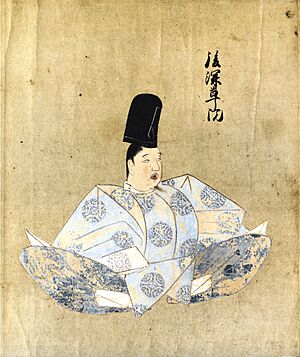Emperor Go-Fukakusa facts for kids
Quick facts for kids Emperor Go-Fukakusa後深草天皇 |
|||||
|---|---|---|---|---|---|
 |
|||||
| Emperor of Japan | |||||
| Reign | 16 February 1246 – 9 January 1260 | ||||
| Coronation | 29 March 1246 | ||||
| Predecessor | Go-Saga | ||||
| Successor | Kameyama | ||||
| Shōgun | Kujō Yoritsugu Prince Munetaka |
||||
| Born | 28 June 1243 Imadegawa-dono (今出川殿), Heian kyō (Japan) |
||||
| Died | 17 August 1304 (aged 61) Nijo-Tominokoji-dono (二条富小路殿), Heian kyō |
||||
| Burial | Fukakusa no kita no Misasagi (深草北陵) (Kyoto) | ||||
| Spouse | Fujiwara no Kimiko | ||||
| Issue more... |
|
||||
|
|||||
| House | Yamato | ||||
| Father | Emperor Go-Saga | ||||
| Mother | Fujiwara no Kitsushi | ||||
| Signature |  |
||||
Emperor Go-Fukakusa (後深草天皇, Go-Fukakusa-tennō, 28 June 1243 – 17 August 1304) was the 89th emperor of Japan. He ruled Japan from 1246 to 1260.
This emperor lived in the 13th century. His name, Go-Fukakusa, means "Later Emperor Fukakusa." The word go- (後) can mean "later" or "second." So, you could also call him "Fukakusa the Second."
Contents
His Name
Before he became emperor, his personal name was Hisahito (久仁).
It's interesting that another member of the Imperial family today has the same name, Hisahito. However, the Japanese characters (kanji) for their names are different:
- Emperor Go-Fukakusa's name was Hisahito (久仁).
- The current Prince Hisahito of Akishino's name is (悠仁).
Emperor Go-Fukakusa was the second son of Emperor Go-Saga.
His Family
Emperor Go-Fukakusa had many children with different consorts. Here are some of his important children:
- With Empress Saionji (Fujiwara) Kimiko:
- Imperial Princess Reishi (1270–1307), who later married Emperor Go-Uda.
- With Consort Tōin (Fujiwara) Inshi:
- Imperial Prince Hirohito, who later became Emperor Fushimi.
- Imperial Prince Mitsuhito, who became a priest.
- With Court Lady Sanjō (Fujiwara) Fusako:
- Imperial Prince Hisaaki, who became an important leader (a shōgun).
His Time as Emperor
Emperor Go-Fukakusa became emperor in 1246 when he was only four years old. His father, Emperor Go-Saga, continued to guide the country from behind the scenes as a "retired emperor." This is called cloistered rule.
In 1260, his father, Emperor Go-Saga, asked Go-Fukakusa to step down. Go-Fukakusa was 15 years old at the time. His younger brother then became the new emperor, Emperor Kameyama.
Sharing Power
After Emperor Kameyama's son, Emperor Go-Uda, became emperor in 1260, Emperor Go-Fukakusa wanted his own son to be the next in line. He talked to the government in Kamakura, called the Bakufu. They agreed that Go-Fukakusa's son, Hirohito, would be the next Crown Prince.
When Hirohito became Emperor Fushimi in 1287, Go-Fukakusa again took on the role of a retired emperor, guiding his son.
An important agreement was made during this time. It decided that future emperors would switch between the descendants of Go-Fukakusa and the descendants of Emperor Kameyama. This led to a long period where two different lines of the Imperial family took turns ruling.
In 1290, Emperor Go-Fukakusa became a Buddhist priest and stepped away from his role as a retired emperor. However, his family's power grew stronger, especially when his seventh son, Prince Hisaaki, became the 8th leader (shōgun) of Kamakura.
Emperor Go-Fukakusa passed away in 1304. He is buried in an imperial tomb called Fukakusa no kita no misasagi in Fushimi-ku, Kyoto.
Important Officials During His Reign
During Emperor Go-Fukakusa's rule, there were a few very powerful officials at the Imperial Court. These men were called Kugyō. They were usually from important families and had a lot of experience. Even though the emperor's court didn't always have much power outside the palace, these officials were still very important within the court.
Some of the top officials during his reign included:
- Sesshō (Regent): Ichijō Sanetsune (1246–1247), Konoe Kanetsune (1247–1252), Takatsukasa Kanehira (1252–1254)
- Kampaku (Chief Advisor): Takatsukasa Kanehira (1254–1261)
Eras of His Reign
In Japan, years are also named after different eras, called nengō. Here are the eras during Emperor Go-Fukakusa's reign:
- Kangen (1243–1247)
- Hōji (1247–1249)
- Kenchō (1249–1257)
- Kōgen (1256–1257)
- Shōka (1257–1259)
- Shōgen (1259–1260)
See also
 In Spanish: Go-Fukakusa Tennō para niños
In Spanish: Go-Fukakusa Tennō para niños

